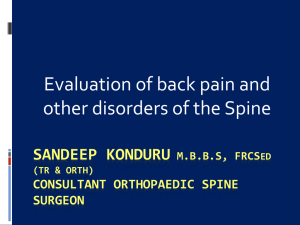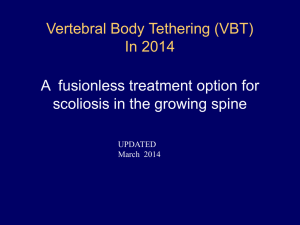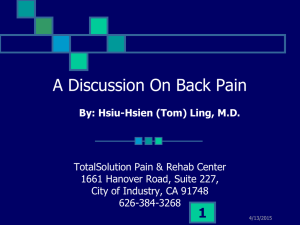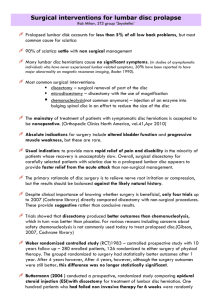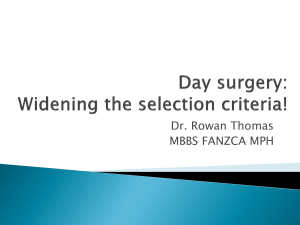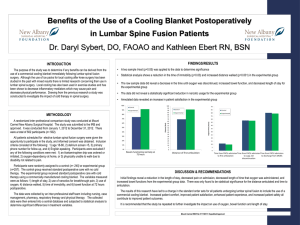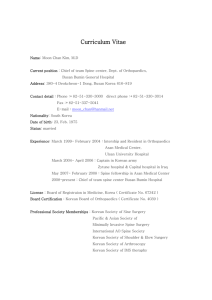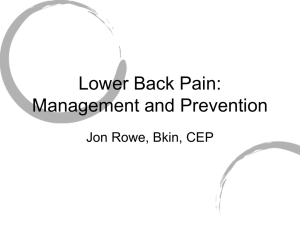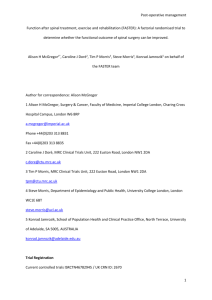01. Spinal Surgery & Post Operative Rehabilitation
advertisement
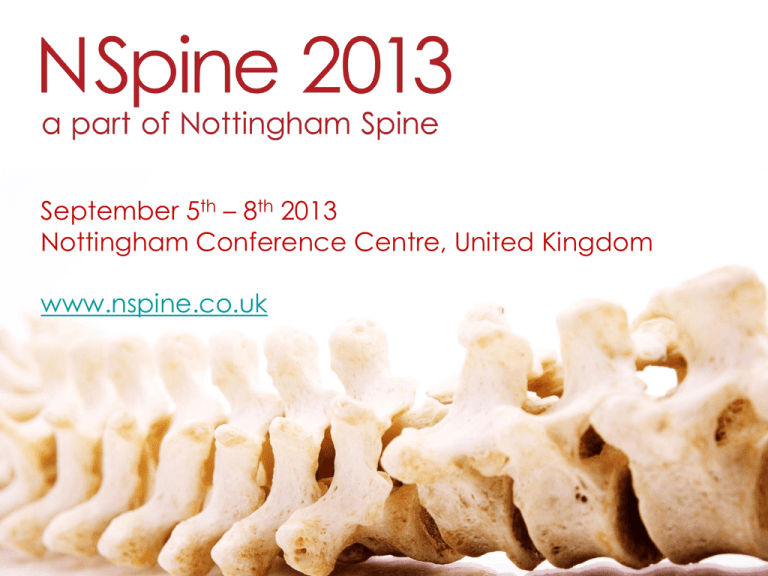
September 5th – 8th 2013 Nottingham Conference Centre, United Kingdom www.nspine.co.uk SPINAL SURGERY & POST OPERATIVE REHABILITATION Evidence Based Considerations Eleanor Dunstan Spinal Physiotherapy ESP EPIDEMIOLOGY • LBP is not decreasing and is a debilitating and costly problem. • >4036 fusions performed in 2009/2010, 14% increase from 2008/2009, (HES 2011) • 10–11,000 operations for radicular pain in the Netherlands, (HCN 1999) • 500-600 open degenerative procedures each year at QMC, (2010-2012 CSSS, AR) LUMBAR SURGICAL RISKS • General Anaesthetic (rare in healthy people) • Infection (2%) • Dural Tear (<5%, higher if previous op) • Nerve Damage (<1%) • Paralysis (very rare) • Blood Loss • Blood Clots(2%) DISCECTOMY Leg pain (radiculopathy), often will co exist with LBP. Outcome: • 60-90% success rate (Deyo, 2006,Ostelo 2003) • 10-40% will have poor outcome, pain, loss of movement, and function, (Ostelo,2003) • Recurrence (<10% at 10yrs), (Ostello et al, 2011) • Improvements may continue for up to 18mts. FUSION Back pain from degenerative joint disease, +/- leg pain. Outcome: • General success rate of 60% (Button et al 2005, Blumenthalet al 2005) • 40% dissatisfied with outcome at 1 year. (Swedish National Spine Register, 2007) • 1 in 4 patients have continued pain and disability post surgery. • Failed surgery (15%)(Rushton et al, 2013) • Adjacent level degeneration (10%)(Rushton et al, 2013) POST OP REHAB WORKS, RIGHT? The good: • Cochranne, 2011: Intensive rehabilitation 4-6 wks result in better short term outcomes compared to no treatment. • Dolan et al, 2000: PT exercise, education and ADL advice beneficial for pain disability, ROM and muscle endurance. • Filiz et al 2005: Intensive exercise, improves lifting from waist to shoulder, abdominal endurance and disability (ODI) • Danielson, 2000 & Manniche, 1993: Short term benefit of exercise. The Bad: • Ostello et al 2003a/b: 6mths behavioural graded activities v usual care. No difference function, pain, fear, ROM, GH, social functioning or return to work. • Donaldson et al 2006: Intensive 6mth rehab v normal ADL’s – no difference. • Mannion et al 2007: No benefit of PT over ‘act as usual’. • Cochranne 2011: 1yr follow up of PT v no treatment – no difference. • Christensen et al 2003: No benefit of PT v HEP, video and support group. • Danielson 2000 & Manniche 1993: no long term benefits of exercise. The Ugly: • Evidence does not tell us which patients should be treated post operatively. • Should we focus on just symptomatic patients? • Fear that active intervention may cause re-injury, reherniation, or instability. • Fusion surgery, inconclusive, low quality evidence available. Rushton et al, 2013 systematic review, retrieved only 2 RCT’s. • Continued development of evidence base is needed. PREOPERATIVE ASSESMENT • High levels of fear and anxiety associated with surgery. • Patients want pre-op education to address the above. • Chronically stressed patients are at higher risk for poor surgical outcome. • Pre op education is common practice in hip replacement, knee replacement, cardiac surgery, abdominal surgery and dental surgery. • Pre op education shown to help increase knowledge of the surgical procedure, reduce anxiety, reduce post operative pain, decrease length of hospital stay and facilitate faster return to function. (Louw 2010,Papanastassiou, 2011) DO CURRENT EDUCATION PROGRAMMES WORK? • Educate patients and reduce pain and disability, outcomes range from ‘excellent’,(Udermann, 2004) to ‘poor’,(Cohen, 1994, Gross 2000). • Traditionally procedural and anatomical information delivered. Could this potentially increase fear? • CBT outcomes show similar results to non-CBT approaches.(Brox, 2008, Johnson 2007) • Neuroscience education shows promise in changing patients fear, perception, attitudes and relationships to pain. (Moseley, 2004) • Studies have revealed results extending beyond the short term. (Moseley, 2003, Oliveira, 2006) PRE OPERATIVE NEUROSCIENCE EDUCATION (Louw et al, 2013) Pain Processing Anxiety/Stress & Pain Surgical Decision Peripheral Nerve Sensitization Surgery & the Nervous System REFERENCES • • • • • • • • • • • • Brox JI, Storheim K, Grotle M, et al. Systematic review of back schools, brief education, and fear avoidance training for chronic low back pain. Spine J 2008;8:948-58. Louw A, Butler D, Diener, et al. Development of a pre op neuroscience education programme for patients with Lumbar Radiculopathy. Am J Phys Med Rehabil 2013:2(5):446-52 Christensen FB, Laurberg I, Bunger CE. Importance of the Back Café concept to rehabilitation after lumbar spinal fusion: a randomized clinical study with a 2 year follow up. Spine 2003;28:2561-9. Cohen JE, Goel V Frank JW, et al. Group education interventions for people with low back pain. An overview of the literature. Spine 1994;19:1214-22 Danielsen JM, Johnsen R, Kibsgaard SK, et al. Early aggressive exercise for postoperative rehabilitation after discectomy. Spine 2000;25:1015-20. Dolan P, Greenfield, K, Nelson RJ, et al. Can exercise therapy improve the outcome of microdiscectomy? Spine 2000;25:1523-32. Donaldson BL, Shipton EA, Inglis G, et al. Comparison of usual surgical advice versus a nonaggravating six month gym based exercise rehabilitation program post-lumbar discectomy: results at 1 year follow-up. Spine J 2006;6:357-63. Filiz M, Cakmak A, Ozcan E. The effectiveness of exercise programmes after lumbar disc surgery: a randomized controlled study. Clin Rehabil 2005;19:4-11. Gross AR, Aker PD, Goldsmith CH, et al. Patient education for mechanical neck disorders. Cochranne Database Syst Rev 2000:CD000962. Johnson RE, Jones GT, Wiles NJ, et al. Active exercise, education, cognitive behavioural therapy for persistent disabling low back pain: a randomized controlled trial. Spine 2007;32:1578-85. Manniche C, Asmussen K, Lauritsen B, et al. Intensive dynamic back exercises with or without hyperextension in chronic back pain after surgery for lumbar disc protrusion. A clinical trial. Spine 1993;18:560-7 Mannion AF, Denzler R, Dorvak J, et al. A randomized controlled trial of post-operative rehabilitation after surgical decompression of the lumbar spine. Eur Spine J 2007;16:1101-17 REFERENCES • • • • • • • • • • • • • Moseley GL. Evidence for a direct relationship between cognitive and physical change during an education intervention in people with chronic low back pain. Eur J Pain 2004;8:39-45. Moseley GL. Joining forces – combining cognition-targeted motor control training with group or individual pain physiology education: a successful treatment for chronic low back pain. J Man Manip Therap 2003; in press. Moseley GL. A pain neuromatrix approach to patients with chronic pain. Man Ther 2003;8:130-40. Moseley GL, Nicholas MK, Hodges PW. A randomized controlled trial of intensive neurophysiology education in chronic low back pain. Clin J Pain 2004:20:324-30. Moseley L. Combined Physiotherapy and education is efficacious for chronic low back pain. Aust J Physiother 2002;48:297-302. Oliveria A, Gevirtz R, Hubbard D. A psycho-educational video used in the emergency department provides effective treatment for whiplash injuries. Spine 2006;31:1672-7. Ostelo RW, Costa LO, Maher CG, et al. Rehabilitation after lumbar disc surgery. Cochranne Database Syst Rev 2011. Ostello RW, de Vet HC, Berfelo MW, et al. Effectiveness of behavioural graded activity after first time lumbar disc surgery: short term results of a randomized controlled trial. Eur Spine J 2003;12:637-44.. Ostello RW, de Vet HC,Vlaeyen JW, et al. Behavioural graded activity following first time lumbar disc surgery: 1year results of a randomized clinical trial. Spine 2003;28:1757-65. Ostello RW, de Vet HC, Waddell G, et al. Rehabilitation following first time lumbar disc surgery: a systematic review within the framework of the cochrane collaboration. Spine 2003;28:209-18. Rushton A, Eveleigh G, Petherick EJ, et al. Physiotherapy rehabilitation following lumbar spinal fusion. BMJ open 2012;2:e000829. Timm KE. A randomized controlled study of active and passive treatments for chronic low back pain following L5 laminectomy. J Orthop Sports Phys Ther 1994;20:276-86. Udermann BE, Spratt KF, Donelson RG, et al. Can a patient educational book change behaviour and reduce pain in chronic low back pain patients? Spine J 2004;4:425-35. APPENDICES NUH Discectomy Rehabilitation Guidelines Phase Goals Treatments Precautions Initial 0-4 wks •Indep Mobility •Correct posture •Indep HEP •Pacing •Pain control •Pain Mx •Patient Education •Postural Awareness •Exercises •Mobility •Paced sitting (20min) •Paced lifting (1-5kg) •Avoid prolonged sitting. •Repetitive/sustained flex •Driving (4-6wk) •Continue log roll (2-4wk) Rehabilitation 4-24wks •Normal Function •Return to work (4wk +) •Return Sport (4wk+) •Normal Movement •Lifting •Pain Mx •Patient Education •Postural Awareness •Exercises •Manual Therapy •Phased return to work •Heavy manual work from 3mts •Heavy lifting >10kg, from 3mts •Contact sports from 34mts Discharge 12wks – 18mts •Achievement of patient goals. •Return to normal activities •Minimal Leg Sx •Continue with paced exercise programme and good posture. •Self Mx strategies •Biopsychosocial Rehabilitation if indicated. Failure to meet goals: •Continue with physio •Consider NBT referral •Refer back to surgical team Pain Relief •Analgesia •Positioning •Adjuncts Education •Pacing •Precautions •Procedure Posture •Sitting •Changing •Repetitive TREATMENT Exercise •Functional core •Spinal Mob •Neural Mob •Gluts / Quads •CV Fitness MT •SSTM •MET •Mobilisations •Taping Mobility •Pre op level •Progress FAILURE TO PROGRESS Problem Causes Management Back Pain •Segmental motion changes •Exercise Technique •Activity/Functional level •Appropriate pain relief •Appropriate exercise level •Check paced walk/sitting •Reassurance Leg Pain •Neural Sensitivity •Appropriate pain relief •Exercises pain free •Reduce sitting •Paced activities •Reassurance can take 4wks •Persistent – consultant r/v Leg parasthesia / sensory loss / weakness •Altered pathoneurodynamics •Appropriate pain relief •Desensitization work with OT •Reassurance / education Exercises Painful •Poor technique •Irritable tissue post surgery •Correct technique •Alter programme •Functional exercise FAILURE TO PROGRESS(cont) Problem Causes Action Patient compliance •Poor understanding of aims, goals and precautions •Explain therapy aims •Patient Education •Goal Setting Inflamed wound •Possible infection •Spinal Clinic Ax •+/- wound swab / bloods •GP/surgical Mx Neurological Deterioration •Possible infection •Sequestrated fragment •Further disc injury •Review and compare neuro status – monitor. •Liaise with surgeon. Headache •Dural Tear •Postural •Pathoneurodynamics •Other pathology •If known dural tear, may take 2 weeks to settle. •Onset after 4wks asses/treat as indicated. •Liaise with surgeon

